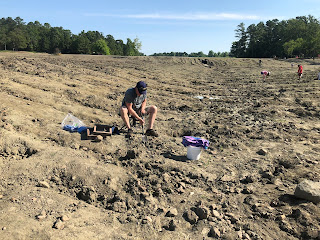 |
The Treasures Found on Our Diamond Dig
(Photos by Sally Matheny)
|
We have panned for gold before since it’s part of our region’s history.
Although today, gold is like an elusive family member in
these parts. Diamonds are like aliens from another planet.
Maybe they’re not as rare as aliens, but the last diamond
found remotely close to where we live was in Kings Mountain, North Carolina.
And that was in 1893!
So we headed to Murfreesboro, Arkansas where thousands of
diamonds have been discovered. Let me tell you about about the treasures we
found on our diamond dig!
In
route, we discussed what we would name our diamond, should we find one, because
that is what you really get to do. It's officially recorded in the books.
Of course, my boy was coming up with crazy names while I
was thinking how much of the gospel I could fit into a name. Don’t laugh! There
has been a 2.93-carat “God’s Blessing,” a 5.16-carat “God’s Glory” (found after
only ten minutes of searching!), and a 2.85-carat “God’s Jewel” which later sold
for $20,000.
So, if the Lord blessed me with a diamond, you bet I was
going to fit Jesus in there somewhere.
Once we arrived, we paid $10.00 each to enter the world’s
only “Keep What You Find” diamond site.
Our enthusiasm to “get rich quick” pushed us quickly
through the informational section of the center. I tried to catch a few glimpses
of an instructional video while the guys went to retrieve mining equipment.
On average, one to two diamonds a day are discovered at the crater, so we wanted to get started and find one before anyone else. Oh, my, that does sound a bit greedy, doesn't it?
 |
| It's all fun in the sun until Mom gets hot and hangry. |
Once on the field, my family’s search techniques varied. My husband picked a spot smackdab in the middle of the thirty-eight acres of plowed volcanic dirt and sat down to sift one bit at a time.
My son found a shady spot on the edge and I began
walking. One of those quick glances at the instructional video mentioned
something about just walking around looking for something shiny. I can’t stay
in one place long, so I set out to meander through the plowed rows.
My plan was for us to search from 8 -12:00, take a break
and eat a picnic lunch, and then search again from 1:00 – 3:00.
Even though we began early in the morning, the
June day heated up quickly. We were glad we brought water. We carried it and the
little shovel and hoe we brought from home in a white five-gallon bucket we
purchased at the park.
So, from time to time, we’d all gather at our
white bucket of supplies, drink water and show our recent finds.
 |
| Are we searching wisely? |
Our pockets quickly filled with rocks we thought looked
unusual enough to hold onto. Perhaps they contained a valuable gem of some sort.
While we knew most of the diamonds found are smaller than a pencil eraser, we also knew a 16.37-carat diamond had been found there in 1975, so if rocks were shiny,
we shoved them in our pockets. We also crammed in a few just for their unusual
green and red colors.
After searching for what seemed forever, I finally found
my husband and told him I thought we must have worked through lunch and
probably needed to stop and go eat. I’m one of those you don’t want to get “hangry.”
I thought surely it was well past 2:00 when I asked my husband for the time. To
my surprise, I learned all the toil and sweat occurred in only three hours. It
was only 11:30! I was so hot, tired, and almost hangry.
I wasn’t the only one. The guys said they’d had enough.
What? But we have not found a diamond! I suggested we at least go to the
sluicing station and rinse off our rocks so the park ranger could identify if
we had any treasures.
And that’s when the truth hit us like a boulder. We had not bothered to take time to listen thoroughly for instructions. Sweaty with exhaustion, we noticed people with more patience and experience working in the cool water.
They had carried dirt in their buckets to the station.
The same kind of bucket in which we had only carried bottles of water and other
things for our comfort.
They were sifting handfuls of dirt and TINY rocks, not at
all like the ones bulging like tumors in our pockets.
After sifting in the water, their trays of dirt were lifted
out, and quickly flipped over on a wooden board. Then, carefully, bit by bit, they studied meticulously, sometimes with the end of a knife, in search of
anything reflective. The deceiving mica was flicked out and the search
continued.
I sensed the seasoned miner in the safari hat trying to suppress
a grin as he saw our empty bucket and bulging pockets.
 Trying to save face, I announced, a bit loudly, to my
son, to “go ahead and wash your SOUVENIR rocks.”
Trying to save face, I announced, a bit loudly, to my
son, to “go ahead and wash your SOUVENIR rocks.”And no, no my son would not do it.
My sweet hubby handled the situation differently. He said, “I’m going to go get a bucket of dirt.”
Then, he watched the others and
tried his hand at sifting. After a while, we called it a
day and went on a picnic.
After I suppressed my hanger with food, we laughed about our experience. The park ranger had kindly identified our pretty souvenir rocks. The "treasures" we
found on our diamond dig were not what we had expected.